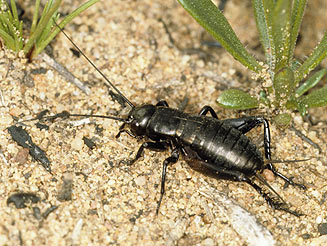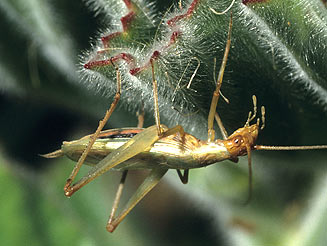|
Family: Gryllidae (true crickets)
Life
> Eukaryotes >
Opisthokonta >
Metazoa (animals) > Bilateria > Ecdysozoa
> Panarthropoda > Tritocerebra > Phylum:
Arthopoda > Mandibulata >
Atelocerata > Panhexapoda >
Hexapoda
> Insecta (insects) > Dicondyla > Pterygota >
Metapterygota > Neoptera > Polyneoptera > Anartioptera >
Orthopterida > Orthoptera > Ensifera > Grylloidea
Occurs worldwide. In southern Africa, there are 42 genera and 123 species native
to the region.
 |
 |
|
Unidentified field cricket (subfamily
Gryllinae) from Cedarberg. |
Tree cricket Oecanthus sp. (subfamily
Oecanthinae) |
The common cricket that comes indoors and calls loudly from behind such places as
the fridge is called Gryllus bimaculatus. Tree crickets are found mainly on plants
where they prey on small insects such as aphids.
Genera native to southern Africa
List from
Orthoptera Species
File.
Gryllinae Group |
|
|
Subfamily: Gryllinae
Worldwide except polar regions. |
|
|
|
Cophogryllini
Northern South America, Africa south of the Sahara,
Mozambique, Asia. |
|
|
|
|
Cophogryllus
Twenty-four species, with a distribution that includes
northern South America, Africa south of the Sahara, Mozambique and Asia.
Seven species are native to southern Africa. |
|
|
|
Gryllini
Worldwide except polar regions. |
|
|
|
|
Acanthogryllus
Six species, with a distribution that includes Africa,
Madagascar and the Indian subcontinent. One species,
Acanthogryllus
fortipes, is native to southern Africa. |
 |
|
|
|
Clearidas
Two species, one in West Africa and the other,
Clearidas nigriceps, native to southern Africa. |
|
|
|
|
Damaracheta
Six species, occurring in southern Africa and Malawi.
Three species are native to southern Africa. |
|
|
|
|
Gryllus
Eighty-five species, occurring worldwide except polar
regions. Nine species are native to southern Africa. |
 |
|
|
|
Gymnogryllus
Forty-two species, with a distribution that includes
Africa, Asia and Australia. Four species are native to southern Africa. |
|
|
|
|
Kurtguentheria
Three species, endemic to southern Africa. |
|
|
|
|
Macrogryllus
Four species, with a disjunct distribution between
southern Africa and South-east Asia. Two species, Macrogryllus capitatus
and Macrogryllus consocius, are native to southern Africa. |
|
|
|
|
Natalogryllus
Three species, endemic to southern Africa. |
|
|
|
|
Scapsipedus
Eighteen species, with a distribution that includes
Africa, Madagascar, Indian subcontinent and the Caribbean. One species,
Scapsipedus meridianus, is native to southern Africa. |
|
|
|
|
Svercus
One species, Svercus palmetorum, with a
distribution that includes the Mediterranean region and southern
Africa. |
|
|
|
|
Teleogryllus
Fifty-two species with a distribution that includes
Africa, Madagascar, Asia as well as islands in the Atlantic, Indian and
Pacific oceans. Six species are native to southern Africa. |
|
|
|
Modicogryllini |
|
|
|
|
Acophogryllus
One species, Acophogryllus schultzei, endemic to
southern Africa. |
|
|
|
|
Astrupia
Two species, Astrupia gazensis and Astrupia
sodwanensis, endemic to southern Africa. |
|
|
|
|
Modicogryllus
Eighty-eight species, with a distribution that includes
Africa, Madagascar, Europe, Asia, Australia, and islands of Atlantic, Indian
and Pacific. Six species are native to southern Africa. |
 |
|
|
|
Velarifictorus
One hundred species, occurring in Africa, Asia, Australia
and North America. Seven species are native to southern Africa. |
|
|
|
Turanogryllini |
|
|
|
|
Neogryllopsis
Nineteen of the twenty species are endemic to southern
Africa. The remaining species is known from Malawi. |
|
|
|
|
Podogryllus
Eighteen species, occurring in Africa and Arabia. Two
species, Podogryllus teres and Podogryllus zambezicus, are
native to southern Africa. |
 |
|
|
Unplaced |
|
|
|
|
Brachytrupes
Seven species, occurring in Africa, Madagascar and Arabia.
Two species, Brachytrupes calaharicus and Brachytrupes testaceus,
are native to southern Africa. |
|
|
|
|
Grylloderes
Twenty-one species, with a distribution that includes
Africa, southern Europe, the Indian subcontinent, and Southeast Asia. Four
species are native to southern Africa. |
|
|
|
|
Taciturna
Two species, Taciturna dlinza and Taciturna
knysna, endemic to southern Africa. |
|
|
Subfamily: Landrevinae
Has a patchy distribution across Central and South
America, Africa, western Indian Ocean islands, Asia and Australia. |
|
|
|
Prolandreva
Two species, Prolandreva aenigmatosa and
Prolandreva mirabilis, endemic to southern Africa. |
|
Phalangopsinae Group |
|
|
Subfamily: Cachoplistinae
Africa, Europe, Asia and Australia. |
|
|
|
Phaeophilacris
Sixty-nine species, occurring in East, West and Central
Africa, extending south to Zimbabwe and Mozambique. Two species, Phaeophilacris picta
and Phaeophilacris spectrum, are native to southern Africa. |
|
|
Subfamily: Luzarinae
Africa, Central and South America. |
|
|
|
Larandeicus
Two species, occurring in Africa south of the Sahara, with
one species, Larandeicus bicolor, native to southern Africa. |
|
|
|
Zaora
One species, Zaora morbillosa, endemic to southern
Africa. |
|
|
Subfamily: Phalangopsinae
Central and South America, Africa, Indian subcontinent,
South-east Asia, New Caledonia. |
|
|
|
Hirpinus
One species, Hirpinus afer, recorded from Angola,
Zambia, Zimbabwe and Mozambique. |
|
|
Unplaced |
|
|
|
Stalacris
One species, Stalacris meridionalis, endemic to
southern Africa. |
|
Podoscirtinae Group |
|
|
Subfamily: Euscyrtinae
Africa, Madagascar, Asia, Australia and Central America. |
|
|
|
Euscyrtus
Twenty-one species, with a distribution that includes
Africa, Madagascar, Asia and Central America. One species,
Euscyrtus bivittatus, is endemic to southern Africa. |
 |
|
Subfamily: Pentacentrinae
Tropical and subtropical regions worldwide. |
|
|
|
Apentacentrus aurantiacus (Mozambique)
One species, Apentacentrus aurantiacus, endemic to
southern Africa (Mozambique). |
|
|
Subfamily: Podoscirtinae
Africa, Madagascar, Asia, Australia, South and Central
America |
|
|
|
Depressotrella
Three species, endemic to southern Africa. |
|
|
|
Homalotrypus
One species, Homalotrypus boromensis, endemic to
southern Africa (Zimbabwe). |
|
|
|
Kilimagryllus
Five species, occurring in Africa south of the Sahara and
Madagascar. One species, Kilimagryllus africanus, is native to
southern Africa. |
|
|
|
Parametrypa
Three species, with a distribution that includes Africa
south of the Sahara and South America. One species,
Parametrypa fortipes,
is native to southern Africa. |
 |
|
|
Rupilius
One species, Rupilius nigrosignatus, endemic to
southern Africa. |
|
Subfamily: Eneopterinae
Central and South America, Africa, Asia, Australia, New Caledonia. |
|
|
Pseudolebinthus
Two species, one recorded from Malawi and the other,
Pseudolebinthus africanus, from Zimbabwe. |
|
Subfamily: Nemobiinae
Worldwide except polar regions. |
|
|
Homonemobius
Four species: three in Asia and one, Homonemobius
africanus, native to South Africa. |
|
Subfamily: Oecanthinae
Worldwide except polar regions. |
|
|
Oecanthus (tree
crickets)
Sixty-four species, with a worldwide distribution
(except polar regions). Thirteen species are native to southern Africa. |
 |
Subfamily: Trigonidiinae
Worldwide except polar and North Temperate regions. |
|
|
Anaxipha
A total of 171 species, with a worldwide distribution
except Europe and Asia (but does occur on the Indian subcontinent). Two
species, Anaxipha gueinzii and Anaxipha natalensis, are native
to southern Africa. |
|
|
Lobeda ovalis
One species, Lobeda ovalis, endemic to southern
Africa. |
|
|
Metioche
Forty species, with a distribution that includes Africa,
Asia, Australia, and South America. One species, Metioche lesnei, is
native to southern Africa (Mozambique). |
|
|
Trigonidium
A total of 171 species, with a distribution that includes
Africa, Madagascar, southern Europe, southern Asia, Australia, and islands
in Atlantic, Indian and Pacific. One species,
Trigonidium
erythrocephalum, is native to southern Africa. |
 |
References
Text and photos by Hamish Robertson
© |
